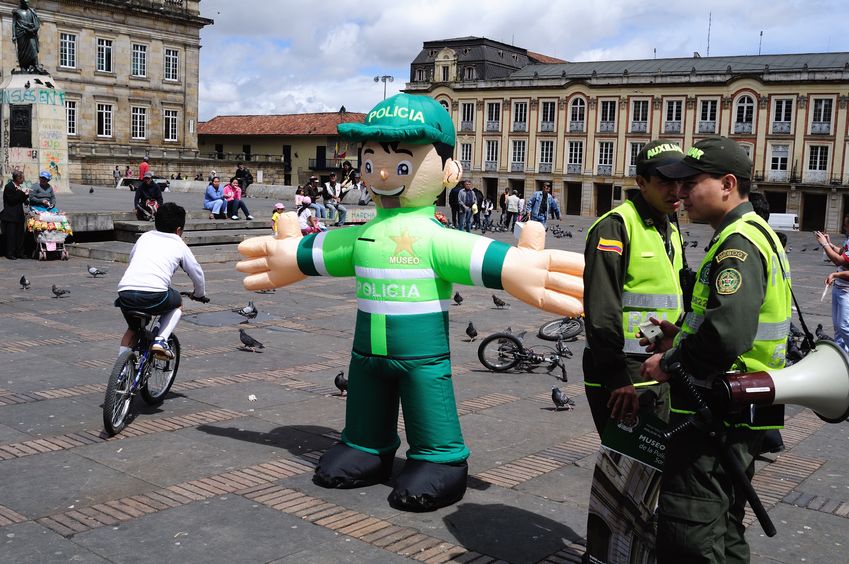While kidnapping of foreigners has decreased dramatically, it still happens. In June 2013, a former U.S. Navy Seal, Kevin Scott Sutay, was kidnapped by the FARC as he was trekking (against the advice of the Colombian police and others) through the Amazonian rainforest towards Ecuador. In 2012, a pair of German brothers who were driving across Colombia in their four-wheel-drive vehicle were kidnapped in the Catatumbo region in the eastern department of Cesar by the ELN guerrilla group, who accused them of being spies. A Norwegian was kidnapped in 2013 as he was attempting to cross through the Darien Gap into Panama on foot. A Spanish couple, touring the deserts of La Guajira in their own vehicle, were kidnapped by common criminals near Cabo de la Vela in May 2013 and rescued by the police about a month later.

While police presence has increased in cities, prevention is the key to avoiding becoming a victim. Photo © Policía Nacional de Colombia, licensed Creative Commons Attribution Share-Alike.
The areas where these foreigners were kidnapped, with the exception of Cabo de la Vela, are known to be volatile regions where tourists would be wise to contract local drivers. While it is a good idea to get informed on the security situation of areas in Colombia before traveling by checking the U.S. Embassy website, some areas are widely known to be iffy for visitors due to the presence of illegal and armed groups. These areas include much of the Amazon region, including the departments of Putumayo, Caquetá, Guaviare, Vaupés, and Amazonas except for around Leticia and Puerto Nariño; the southern Llanos (visiting Caño Cristales by plane is OK); the department of Arauca; the Catatumbo region of Cesar and Norte de Santander; most of the Chocó department, with the exceptions of Quibdó and the coastal tourist areas of Bahía Solano and Nuquí; the Darien Gap region, including the Los Katios park (Capurganá and Sapzurro are considered safe); and parts of Cauca near Santander de Quilichao.
Around tourist attractions in large cities, there is a strong police presence. This is especially true in the Old City of Cartagena and in the Centro Histórico of Bogotá. Street crime and homelessness are problems in poor neighborhoods and downtown areas of all the major cities after dark.
Particularly in Bogotá, but in other large cities as well, countless locals and visitors alike have been victims of the taxi crime of paseo milonario (the millionaire’s ride). This occurs when you take a cab off the street, and within minutes the driver makes a sudden turn or invents an excuse that he needs to stop. At that point, usually two others will jump into the cab on either side of the victim and will threaten him or her at knife or gunpoint. The victim will then be driven to several ATMs in the city and forced to withdraw large amounts of cash. This crime tragically claimed the life of an American Drug Enforcement Agency agent in 2013 in Bogotá. Largely due to this crime, which soiled Colombia’s reputation abroad, authorities have redoubled their efforts to prevent this crime and prosecute the perpetrators.

Around tourist attractions in large cities, there is a strong police presence. Photo © Carlos Mora/123rf.
Prevention is the key to avoiding becoming a victim. Always order a cab by phone or by the popular and free smartphone application Tappsi (available in most cities). When you order a cab, or have one ordered for you, be sure to jot down the placas (license plate numbers). The operator will give these to you. When the cab arrives, confirm the placas. It is especially important to order a cab at night and when leaving upscale restaurants, shopping areas, and nightclubs.
Another crime to be aware of is poisoning. Poisoning most often occurs in nightclubs, when someone will either poison your drink or offer you a drink that has been poisoned. They will then easily persuade the victim to leave the club with them, and will force him or her to withdraw large sums of money from ATMs or will rob the victim of possessions. Although this is commonly called burundanga poisoning, after a flower called the borrachero whose seeds, when consumed, can render one helpless and in a zombie-like trance, the drug used by most criminals is not from the flower but a potent cocktail of drugs including the anti-anxiety drug lorazepam.
Excerpted from the First Edition of Moon Colombia.